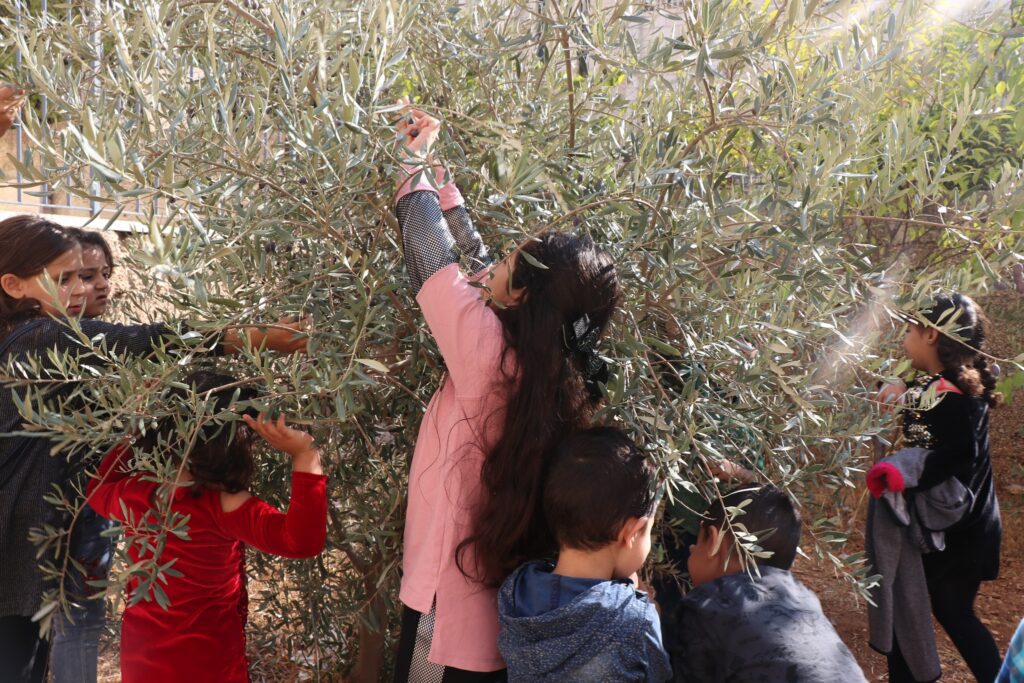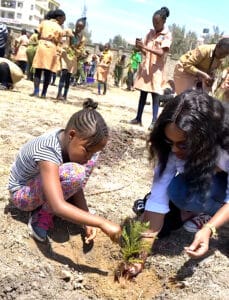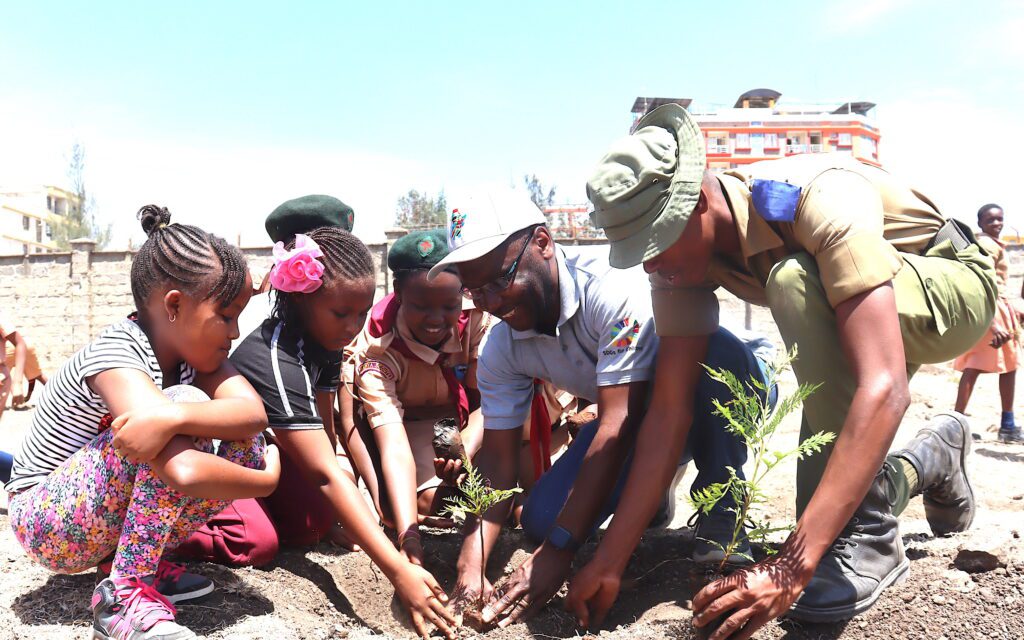
Planting Seeds of Peace in Children


Palestine, a country on the eastern coast of the Mediterranean Sea, to the south of Lebanon, and to the west of Jordan is uniquely a holy land in three of the world’s major religions–Islam, Christianity, and Judaism. One of the basic components and values that Palestine lacks and aspires to achieve is peace since it is a country under occupation. Various Palestinian institutions seek to reach both inner community peace and external peace. They do so by spreading awareness and applying practices and procedures needed to deepen the values of peace among different groups.
Children are one of the main actors we should work with. They are the leaders of tomorrow and the builders of the future who will form the basic layer for building a peaceful society in Palestine. To do so requires more focus and care teaching children and training them to apply this concept of peace in practical and amicable ways through campaigns and initiatives asking for rights and seeking change.

In many countries the olive tree symbolizes peace, and certainly so in Palestine. Palestine is famous for its olive trees which are hundreds of years old and whose olives are delicious. The olive tree is also a symbol of the Palestinian people’s connection to the land and the solidity of its roots.
Community Harmony and Living Together
The Arab Educational Institute (AEI) – a member organization of Pax Christi International, located in Bethlehem – is a Palestinian non-profit organization working in the field of community education and awareness through educational projects and programs. AEI targets various segments of Palestinian society, including youth, women, and children. Peace is one of the main concepts of AEI’s mission. It teaches this concept in two dimensions: inner peace with oneself and external peace with the environment, society, and the world.
Children are the main target group of the AEI within its children’s group and among students of the schools’ network in Bethlehem, Ramallah and Hebron cities. Teaching and training on peace are carried out through awareness-raising, educational lectures, training workshops, and non-violent activities such as advocacy campaigns, education through art, music, drama, and writing stories. The AEI focuses in its work with children and school students on the concepts and values of citizenship, civil peace and living together through its longstanding program ‘Citizenship and Diversity: Christian/Muslim Living Together in Palestine’.
“Peace is a word with a beautiful and good meaning. It gives us calm and serenity. It is the presence of harmony and love between people and it means staying away from wars and conflicts.” – Child, AEI
Peace is one of the basic concepts and values that must be learned and practiced in life because the lack thereof results in conflicts. To achieve peace, its seeds should be planted from a young age in children so that the fruits can be reaped when they grow.
Claudette S. Mubarak, GNRC Country Communications Associate, Pakistan
Bethlehem
18.10.2022
The post Planting Seeds of Peace in Children appeared first on Global Network of Religions for Children.
The post Planting Seeds of Peace in Children appeared first on Arigatou International.

Children as flagbearers of hope

Growing trees with children
“Mummy, when are we going back to see the tree that I planted? I want to water it and see how tall it has grown!”
Above is a persistent question from my beautiful 8-year-old daughter. Her name is Natalie.
Celebrating 10 years of work and commitment to ending child poverty, as part of the ECP@10 grow trees with children campaign, on 22nd October 2022 Arigatou International’s, End Child Poverty led by an amazing team, joined efforts in a tree planting exercise. The event took place at Administration Police Training College (APTC), where over 10,000 trees and tree seedlings were donated and planted.
The grow trees with children campaign was informed by the reality that climate change is unquestionably an ongoing threat to poverty reduction. Climate change is further a direct threat to a child’s ability to survive, grow, and thrive. Often, children bear the indirect brunt of climate injustice particularly those already living in poverty.

Remember when we said we are ‘leaving no one behind’– a pledge that lies at the heart of the SDG framework? Well, Halfway to the deadline for the 2030 Agenda, the SDG Progress Report; Special Edition shows we are leaving more than half the world behind. I am certain that all who have put in the work towards achieving the latter are disappointed but not surprised. The same report highlights that we have entered an age of poly-crisis where conflict, climate change, the lingering effects of the COVID-19 pandemic, and other global challenges are threatening to derail hard-earned progress toward the achievement of the SDGs. My supervisor Dr. Mustafa Y. Ali, Secretary General of the Global Network of Religions for Children, a man who sought after my own heart due to his passion for children and their well-being believes that the 4th of the 3 C’s (mentioned above) is CHILDREN. Yes! Children… why children you may wonder? The answer is simple, ‘If we care for them today, they will change the world tomorrow.
Think about it! If we are truly working towards building a better world, more so for children, why not involve them in the processes that will lead to the achievement and retention of the same? I couldn’t agree more, an investment in the child today, is additionally one in the future—a better future!
At my daughter’s tender age, through the tree planting exercise, she has learned 1) the value of planting a tree (more biblical for me, I could share endless quotes from the bible that document the same, actually, I will; refer to 2 Corinthians 9:10) and 2) that for anything to grow, it must be nurtured. The tree she planted should be 8 months old now. I don’t know what her expectations are… I hope she is neither disappointed nor surprised (pun intended); back to her question, I will take her to visit her tree, soon!
I can’t help but imagine a world where every child understands what planting a tree today can do for the world tomorrow. How do we equip our children with skills and knowledge that present a sustainable environment and respond to the need for climate action?
A humble start towards the same would be, Joining and supporting the ‘grow trees with children’ campaign and donating to this great course.

Allow me to leave you with a Chinese proverb “The best time to plant a tree was 20 years ago. The second best time is now.
Heartfelt gratitude to my friends and colleagues!
The post Children as flagbearers of hope appeared first on End Child Poverty.
The post Children as flagbearers of hope appeared first on Arigatou International.

The Word Of The Day Is Entertaiment
The Word Of The Day Is Entertaiment
To entertain is to amuse, divert or occupy the attention of; provide pleasure or diversion. Entertainment can range from the private amusement of a child playing with dolls or group games, to elaborate entertainment for hundreds of people at a ball or theatre performance. It can involve the active participation of the audience or it can be a sedentary activity, such as reading a book or solving a crossword puzzle. Entertainments may be a form of escapism or they may have a serious purpose, as in the case of ceremonies, religious festivals or satire. For example, the story of Scheherazade, an ancient Persian professional storytelling tradition, has inspired a number of orchestral works by Rimsky-Korsakov and Ravel, a film by Pasolini and an innovative video game.
The post The Word Of The Day Is Entertaiment appeared first on www.snvla.org.

The Importance of Automobiles
Automobiles are motor vehicles that are designed to transport passengers. They are powered by an internal combustion engine fueled most commonly by gasoline, a liquid petroleum product. The automobile was one of the most revolutionary inventions in modern times, transforming life by allowing individuals to travel long distances independently and quickly. This invention also gave rise to a variety of services like restaurants, hotels and amusement parks. However, it came with some disadvantages as well like air pollution and a drain on the world’s scarce oil reserves.
The automobile was first introduced in the late 1800s but did not achieve worldwide dominance until the early 20th century when Henry Ford revolutionized mass production techniques that allowed automobiles to be affordable for the middle class. This trend was accelerated by the wartime demand for military vehicles which led to the rapid expansion of auto manufacturing. The United States became a major automotive industry, with Detroit manufacturers becoming the dominant force.
As technology advanced, the automobile became a means of social change, enabling women to work and have a sense of independence. This freedom also allowed women to campaign for women’s rights, such as voting rights. In the 1920s, women clad in suffragette uniforms drove around with “votes for women” banners hanging from their cars. This movement paved the way for women to become political leaders, journalists and even astronauts.
The automotive industry continued to progress with innovations like electric ignition, automatic transmission and four-wheel brakes. The development of the pistonless rotary engine, which is more efficient than a conventional reciprocating engine, has yet to find a wide market.
Today, automobiles have become a necessary part of modern life and it is almost inconceivable to imagine what a society would be like without them. They are used for commutes, to get to school and work, to go shopping and to travel. Many of these cars are equipped with safety features, including seatbelts and airbags. Some of the more recent safety features include blind-spot monitoring systems, lane-keeping assist and adaptive cruise control.
Besides the obvious convenience, owning a car can save time and money. People who don’t have a car have to rely on public buses or friends and family for rides, which can be costly. Additionally, if you have to go out of town for work, owning a car can make this easier. Another benefit of owning a car is privacy. Having a car allows you to go anywhere in the country and not have to rely on others.
The future of the automobile depends on many factors, such as safety laws and alternative fuels. Automakers are now focusing on producing more environmentally friendly cars and introducing new technologies like hybrid, electrical and autonomous cars. These changes will help the automobile industry adapt to the changing climate and increase its global competitiveness. As the automobile evolves, it will have to keep up with society’s changing needs, such as a growing population and increasing urbanization.
The post The Importance of Automobiles appeared first on www.snvla.org.

What Is a Slot?
A slot is a slit or narrow opening. It can also refer to an assignment, position or period of time.
Slot receivers, who play on the outside of the offense’s three-receiver sets, are usually shorter and faster than wide receivers. They have become increasingly important to NFL teams, which often use them in combination with tight ends. They are also a key component of many college and high school football programs.
It’s common for players to feel like they can control the outcome of their slots games, but it’s important to remember that winning or losing at slot machines is a matter of chance. There are a few things that you can do to improve your chances of winning, however. One way to do this is by choosing a machine that has a higher payout percentage. Another is by using auto spin. This feature allows you to automate your game, which can save you time and energy by eliminating the need to press the start button over and over again.
Some people try to manipulate the odds of winning by hitting buttons at certain times, rubbing machines, or tracking ’near misses’ in order to predict when a slot is likely to pay out. It’s important to understand that these tricks do not work and are not a foolproof method of beating the odds. Instead, focus on finding the best slot for you by combining factors such as volatility, RTP, betting limits, and bonus features.
The best online slots are designed to offer the highest possible return-to-player (RTP) rate, while still being fun and exciting. They are also made with beautiful graphics and sounds to make them even more immersive. You can even find some slots with progressive jackpots, which increase in size every time you place a bet.
There are so many different kinds of slot games that it’s difficult to know which ones are the best for you. Some are more complex than others, and it’s important to understand the differences between them before making your decision. In general, the more complex a slot is, the more time and money was invested in its development. However, this doesn’t necessarily mean that it is the best for everyone.
The key to success when playing slot is speed and concentration. Getting there early is crucial, but it’s easy to get distracted by relaxing by the pool, sipping one more drink in the lounge, or sharing your experience with other players. Getting distracted will make it hard to keep up with the fast pace of the game, and may cause you to lose out on valuable opportunities.
The post What Is a Slot? appeared first on www.snvla.org.






